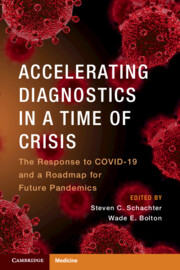 Accelerating Diagnostics in a Time of Crisis
Accelerating Diagnostics in a Time of Crisis Published online by Cambridge University Press: 06 January 2024
The aim of this chapter is to discuss the foundational knowledge of the occurrences, events, and disease manifestations that was developed during the early stages of the COVID-19 pandemic, including the responses and measures that were undertaken to contain the disease. It emphasizes the importance of early intervention and the impact that timely action – or, in many cases, inaction – had on the development of this pandemic crisis. This chapter explores the role of data collection and the analysis mechanisms utilized in this pandemic to monitor disease spread in different geographies. The necessity of information derived from early disease vigilance and subsequent surveillance programs is stressed. The participation of the different stakeholders in the control and management of the pandemic is discussed as a function of synchronized intervention and effectiveness. This chronological account is intended to create a roadmap for future undertakings, programs, and decision-making processes by health and governmental authorities to be conducted at the earliest phases of future pandemics.
To save this book to your Kindle, first ensure [email protected] is added to your Approved Personal Document E-mail List under your Personal Document Settings on the Manage Your Content and Devices page of your Amazon account. Then enter the ‘name’ part of your Kindle email address below. Find out more about saving to your Kindle.
Note you can select to save to either the @free.kindle.com or @kindle.com variations. ‘@free.kindle.com’ emails are free but can only be saved to your device when it is connected to wi-fi. ‘@kindle.com’ emails can be delivered even when you are not connected to wi-fi, but note that service fees apply.
Find out more about the Kindle Personal Document Service.
To save content items to your account, please confirm that you agree to abide by our usage policies. If this is the first time you use this feature, you will be asked to authorise Cambridge Core to connect with your account. Find out more about saving content to Dropbox.
To save content items to your account, please confirm that you agree to abide by our usage policies. If this is the first time you use this feature, you will be asked to authorise Cambridge Core to connect with your account. Find out more about saving content to Google Drive.